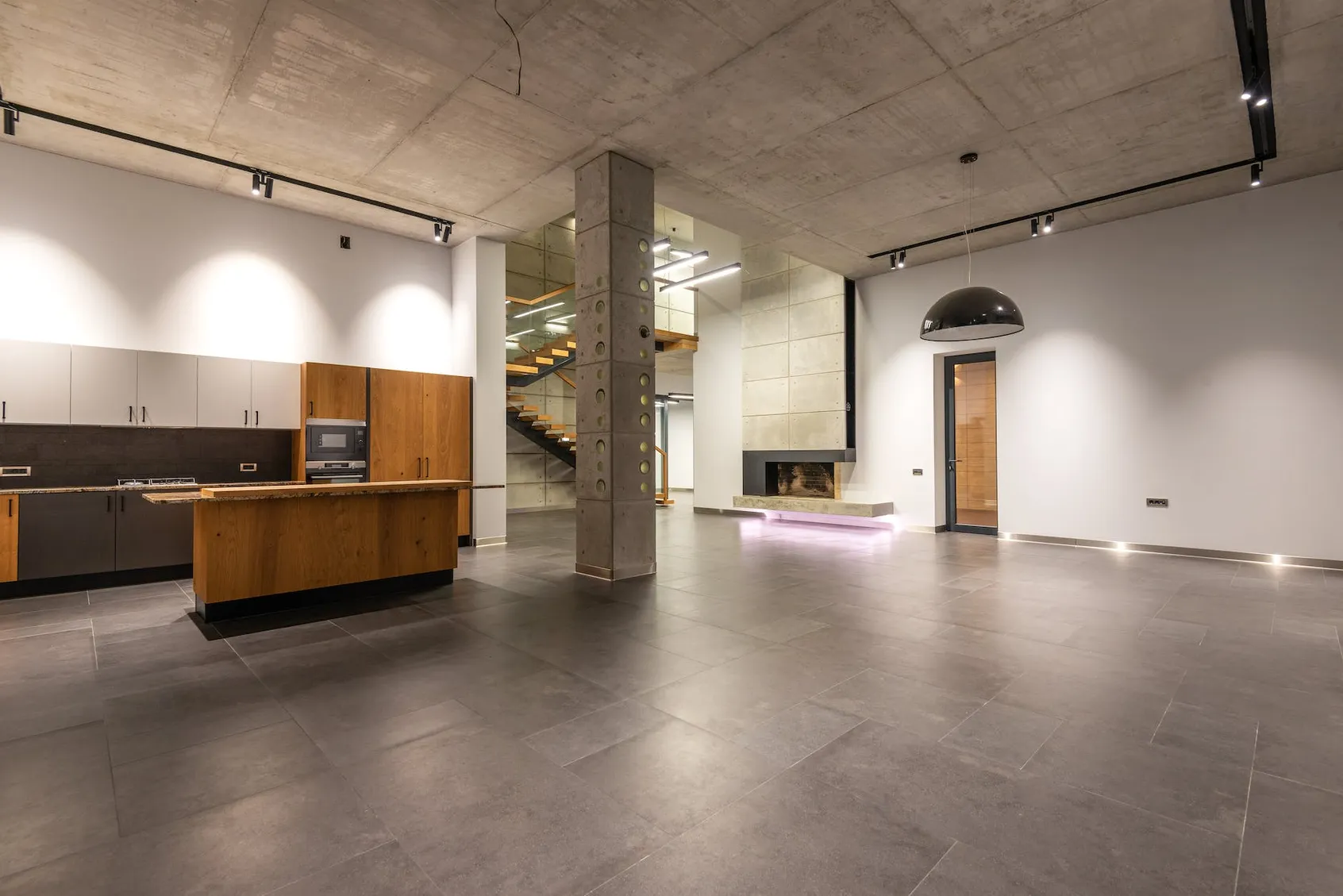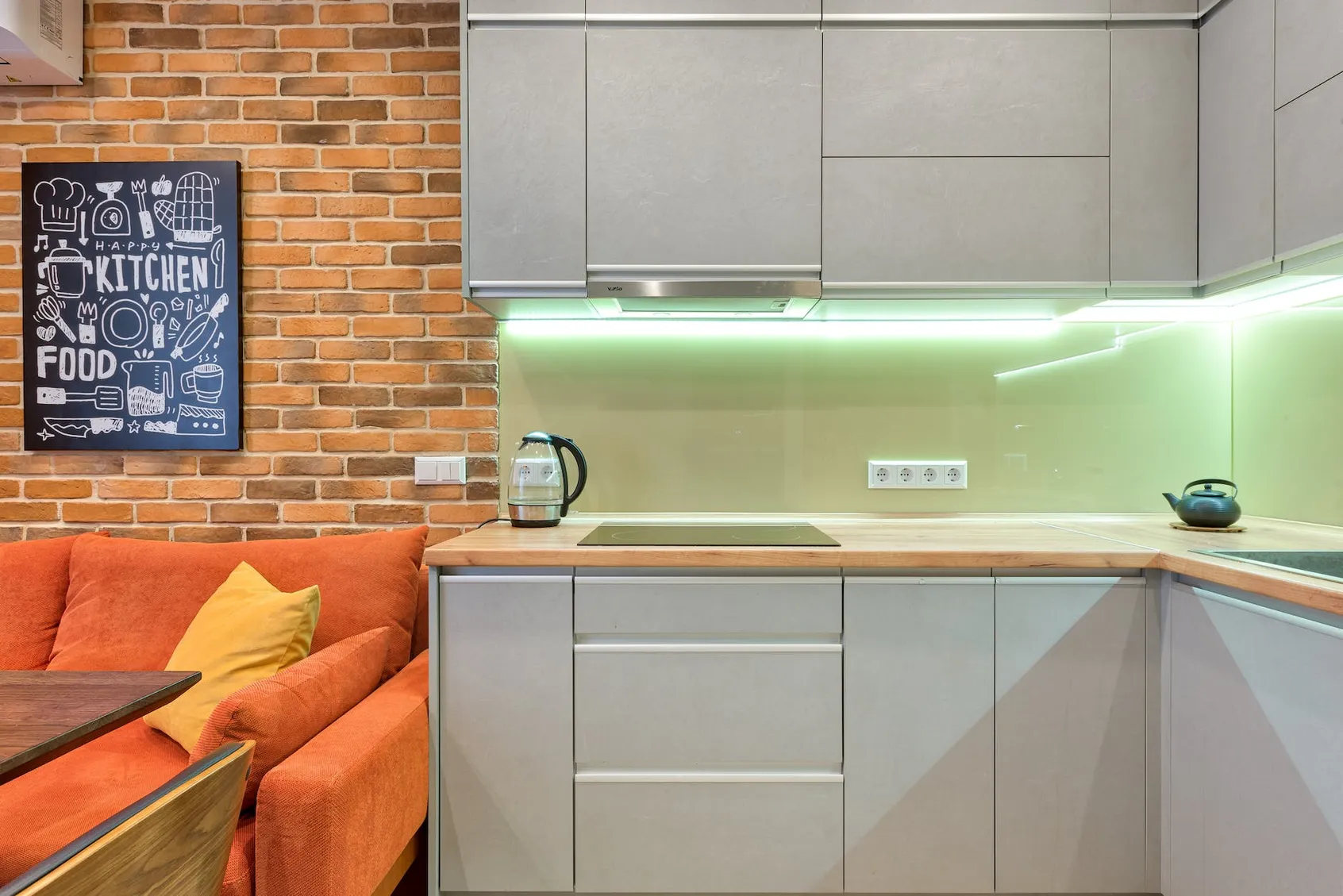Replacing your kitchen floor can be daunting, especially when you consider the potential of having to remove your cabinets. But can you replace the kitchen floor without removing the cabinets?
Fortunately, replacing your kitchen floor without removing your cabinets is possible, saving you time and effort. In this article, we will discuss the steps you need to take to replace your kitchen floor without removing your cabinets.
Can You Replace Kitchen Floor Without Removing Cabinets?
Replacing the flooring around your kitchen cabinets can be daunting, but it doesn’t have to be. With the right supplies and preparation, installing new flooring around your kitchen cabinets can be done without removing them, saving you time and money.
The first step is to prepare the area. Ensure all the old floorings are removed and the area is clean and dry. You may need a putty knife to remove any caulking or old glue. Once removed, sweep the area and vacuum the edges to ensure all the debris is removed.
Next, you can begin laying the new flooring. If you’re using tiles, lay them in a pattern that will look good, and make sure you have enough to cover the area. Using sheet flooring, carefully measure the area and cut the pieces to fit.
Once the flooring is in place, you can install the trim around the edges and against the cabinets. Ensure the trim is level, and use caulk to seal any gaps. You can install the baseboards once the trim is in place and dry.
Finally, you can put the finishing touches on your new flooring. If you’re using tiles, grout the seams and seal the grout. If you’re using sheet flooring, make sure to apply a sealant to protect it from moisture.

Preparing The Subfloor
First, use a utility knife to score and cut through the existing flooring. Ensure to cut to the subfloor, careful not to damage the cabinets. Once the floor is cut, use a pry bar to lift the sections of old flooring. It is a good idea to wear gloves, as you will be dealing with sharp edges.
Once the floor is removed, the vacuum cleans up all the debris. Be sure to get all the dirt and dust to help install the new floor. Using a hammer to drive nails back into the subfloor if nails stick up. Once the subfloor is clean, you are ready to install the new flooring.
Choosing The Right Flooring Material
Choosing the right flooring material is key when replacing your kitchen floor without removing the cabinets. Various options are available depending on your budget, tastes, and needs.
- Hardwood is a classic choice known for its durability and timeless beauty. However, hardwood can be expensive and require additional work to achieve the desired result.
- Tile is another very durable option and relatively easy to install. Tile can also be easily customized to fit any room size and design.
- Vinyl flooring is a great option if you want something more affordable and easier to install than tile. Vinyl flooring is available in various colors, textures, and patterns and is also waterproof, making it a good choice for kitchens.
- Laminate flooring is popular as it is easy to install and comes in various colors and styles. Laminate flooring is also very durable, making it a great option for busy households.
No matter what flooring option you choose, it is important to take the time to choose the right material and ensure it is installed properly. Researching and selecting the right flooring material will help ensure that your kitchen floor looks great and lasts for years.
Measuring And Cutting Floor Tiles
First, you must measure the floor to determine your needed tiles. Once you know the measurements, you can purchase tiles in the size, color, and material you choose. Make sure to buy extra tiles if you need to adjust.
Once you have the measurements, you can begin to cut the tiles. This is a delicate process; you should take time to get the right cuts. Make sure you use a high-quality tile cutter and measure twice before cutting. If you make a mistake, replacing it could be costly and time-consuming.
Installing The Floor Tiles
Once your tiles are cut, it is time to start laying them on the floor. You can use a notched trowel to spread the adhesive on the back of the tile before placing the tile on the kitchen floor.
You can use spacers to make sure the tiles are even and have the same distance between them. Press down firmly as you lay the tiles to ensure the adhesive sticks to the floor. You can use a rubber mallet to help secure the tiles.
Once the surface is prepared, you can begin laying out the tiles. Start in one corner and work your way out so you don’t miss any spots. You can use a chalk line to help you keep the tiles straight.
If you install ceramic tiles, you must use a notched trowel and thin-set mortar to spread a layer of adhesive onto the subfloor before laying the tiles down. However, using vinyl tiles, you can lay them directly onto the floor and use a roller to press them into place.
Sealing And Grouting The Floor Tiles
The step is to seal and grout the floor tiles. This involves ensuring all the tiles are properly sealed and the grouting between them is properly applied. This will help protect the tiles from water damage and give them a cleaner and more professional look.
Once the adhesive is dry and the tiles are firmly in place, you can grout the tiles. This will help fill the gaps between the tiles and ensure the floor is even and secure. Mix the grout according to the manufacturer’s instructions, then spread it over the tiles. Use a rubber float to push it into the joints between the tiles, and then use a damp sponge to clean off the excess.
After the grout is dry, you can seal the floor with a sealant. This will help protect the tiles and make them last longer. The sealer will also help to keep the tiles from becoming slippery. Once the sealer is in place, you must use a grout float to smooth out any bumps or ridges in the grout. This will help ensure the tiles stay in place and look their best.

Finishing Touches
Once the new kitchen floor is installed, it is important to take the time to complete all of the finishing touches. To ensure a successful installation, the seams and edges should be sealed with heavy-duty caulking, and the perimeter should be trimmed and finished with matching trim. This will help to prevent moisture from seeping into the seams, which could lead to further damage and costly repairs.
Additionally, any exposed nails should be properly set and countersunk. Any screws or nails in contact with the new kitchen floor should be covered with a protective finish, such as a metal washer.
Fixing Loose Cabinets
Replacing a kitchen floor without having to remove the cabinets is a task that most homeowners can manage. The first step is to address any loose cabinets that may have been caused by neglect or age.
The most common way to fix loose cabinets is to use a drill and screws to secure them to the wall. If the cabinets are very old and rotted, replacing the screws with new ones may be necessary.
Once the loose cabinets are secure, the next step is removing old flooring. This can be done using a crowbar and hammer to loosen the old flooring and then using a vacuum to remove debris.
Replacing Baseboards
The key to a successful floor installation is to start by replacing the baseboards. Baseboards are the moldings that run along the base of the wall and provide a finished look to the floor. Replacing the baseboards is a fairly simple process that can be completed in just a few hours.
To begin, measure the height of your baseboards and purchase the same size of baseboard molding. If the existing molding is in good condition, you can use it for the new floor. Next, remove the old baseboards and any nails that may be left behind. If the old baseboards are not in good condition, you can use a pry bar to remove them.
Once the old baseboards are removed, it is time to install the new baseboards. Start by cutting the baseboard to the desired length. If the baseboard is being cut to fit around a corner, cut the baseboard slightly longer to allow for the corner. Once the baseboard is cut to length, you will need to use a miter saw to cut the ends of the baseboard to fit around the corner.
Next, use a screw gun to secure the baseboard to the wall. Drill pilot holes into the wall before inserting the screws, and make sure the baseboard is level before securing it. Once the baseboards are securely attached, you can install the flooring. Depending on your type of flooring, you will need to use nails or staples to secure the flooring.
Cleaning And Caring For Your New Floor
Cleaning and caring for a new kitchen floor is essential to ensure it looks its best for as long as possible. Here are some tips to help you keep your kitchen floor in pristine condition:
- Sweep or vacuum regularly: Dirt, dust, and debris can quickly accumulate on the floor, so it’s important to sweep or vacuum regularly to prevent them from building up.
- Use a pH-neutral cleaner: When cleaning your kitchen floor, use a pH-neutral cleaner. This will help maintain the integrity of the floor’s finish and prevent damage.
- Wipe up spills immediately: Spills can quickly stain and damage your kitchen floor, so wiping them up as soon as they happen is important. This will help to prevent any long-term damage.
- Use mats and rugs: Placing mats and rugs in high-traffic areas can help to protect your kitchen floor and prevent scratches and wear and tear.
- Avoid harsh chemicals: Harsh chemicals, such as bleach or ammonia, can damage your kitchen floor’s finish. Stick to gentle cleaners and avoid anything that may be too abrasive.
Kitchen Floor Replacement Cost
Kitchen floor replacement costs can vary depending on the type of flooring you choose and the room size. Generally, replacing a kitchen floor costs between $1,500 and $3,000.
It can save money by replacing the kitchen floor without removing the existing cabinets. This can be done by covering the existing floor with a new flooring material or cutting the new flooring to fit around the cabinets.
Another cost to consider is the labor to install the new flooring. Depending on the type of flooring chosen, the labor cost can range from $500 to $1,000 for installation. Researching and comparing different contractors’ prices is important to find the most cost-effective option.
In addition to the cost of the flooring and labor, it is also important to consider the cost of any additional materials that may be needed to complete the job. This could include adhesives, grout, sealants, and other materials. Again, comparing prices from different suppliers is important to ensure the best deal.
Finally, it is important to note that the cost of replacing a kitchen floor without removing the cabinets will depend on the size of the room, the type of flooring chosen, and the complexity of the installation. It is best to get several quotes from different contractors before deciding.

Troubleshooting Common Issues
When replacing a kitchen floor, a few common issues can arise. Here are some troubleshooting tips to help you tackle these challenges:
- Uneven subfloor: Ensuring the subfloor is completely level before installing a new kitchen floor is important. If you notice any bumps or dips, you may need to use a self-leveling compound or other materials to create a smooth, even base for your new floor.
- Moisture problems: Moisture is a common issue in kitchens, and it can cause problems for your new floor if not properly addressed. Install a vapor barrier and use water-resistant materials to prevent water damage and mold growth.
- Incorrect measurements: Measuring accurately is crucial when replacing a kitchen floor, as even small errors can cause major problems later. Take multiple measurements and double-check your calculations to ensure you have the correct amount of flooring and other materials.
- Improper installation: Incorrect installation can lead to gaps, buckling, and other issues with your new floor. Be sure to follow manufacturer instructions carefully and consider hiring a professional installer if you’re not confident in your skills.
How To Replace Tiled Kitchen Floor?
Here are the steps to follow when replacing a tiled kitchen floor without removing the cabinets.
First, you must prepare the area by removing the existing tiles. Be sure to wear safety goggles and gloves to protect yourself from any debris that may arise. A chisel, hammer, and razor blade can remove the tiles. Carefully scrape away the adhesive left behind to ensure the new tiles adhere securely.
Next, you will need to measure the area for the new tiles. Measure the length and width of the room and mark the area on the floor with a pencil. This will be your guide when you lay down the new tiles.
Once the layout is marked, you must prepare the surface for the new tiles. Remove dirt and debris from the surface using a sponge and warm water. Allow the area to dry completely before proceeding.
Now it is time to lay down the new tiles. Begin in the corner and work your way out. Make sure to use the pencil lines as a guide. Use a level to ensure that the tiles are even and level.
Once the tiles are laid, you must use grout to fill in the gaps between them. Use grout specifically designed for tiled floors and follow the manufacturer’s directions. Allow the grout to dry completely before continuing.
Finally, you will need to seal the tiles. This step is important to protect the tiles from stains and water damage. Apply the sealant and allow it to dry completely before walking on the new floor.
Laminate Flooring
If you want to replace your kitchen floor but don’t want to take the time and effort to remove your cabinets, consider installing laminate flooring. Laminate flooring is a great choice for a kitchen floor because it is easy to install, highly durable, and comes in various colors and styles.
Laminate flooring is created from multiple layers of synthetic materials and is designed to look like real wood or stone without the cost and maintenance associated with these materials.
When installing laminate flooring in your kitchen, you must first measure the area to purchase the appropriate laminate planks. Once you have the planks, lay them out on the floor, leaving a small gap between the walls and the planks.
Then, use a rubber mallet to tap the planks into place, ensuring they are level and even. When you are finished, you can use a jigsaw to trim the planks so they fit around any obstacles, such as cabinets or islands.
To ensure your laminate flooring lasts long, you must seal it with a moisture-resistant sealant. This will keep the floor protected from any water or spills that may occur in the kitchen. Additionally, you should clean the floor regularly with mild detergent to remove any dust or dirt.
Polyvinyl Chloride
Polyvinyl chloride (PVC) is ideal for replacing your kitchen floor without removing the cabinets. PVC is a durable and waterproof material that is easy to install and provides a wide variety of options for customization and design.
It can be installed over different flooring surfaces, including concrete, ceramic tile, and laminate. The material is also non-porous, so it will not absorb any liquids or spills, making it easy to clean and maintain.
The installation process for PVC is relatively simple. First, you should prepare the floor by cleaning it thoroughly and patching any holes or cracks. Once the floor is ready, you can lay down the vinyl.
You must use a heavy-duty adhesive to secure it to the existing flooring and the cabinets’ base. It is important to spread the adhesive evenly and securely so that the floor does not move once it is laid down.
Once the adhesive is dry, you can cut the PVC into the desired shape. You should ensure that all edges are cut precisely to ensure a neat and even finish.
Many use a wet saw to make the cuts, providing a more accurate finish. Once the pieces have been cut and laid down, you will need to use a sealant to provide an extra layer of protection and to keep the floor in place.
How To Level Kitchen Floor Without Removing Cabinets?
Leveling a kitchen floor without removing the cabinets can be done in several ways. First, you must assess any unevenness in your floor with a spirit level and address any steps or dips.
- One way to do this is by using self-leveling compounds, either mixed or pre-mixed. These are applied over small areas of the floor and then left to dry until hardened – you may need to work quickly with these as they start to thicken after being mixed. Once dry and set, they will hold firmly regardless of any slight unevenness around the edges.
- Another option is to use shims or wedges beneath different sections of cabinets or appliances – these can help raise any areas that have sunk slightly and ensure everything sits uniformly on the surface of your kitchen floor.
How To Remove Flooring From Under Cabinets?
Removing flooring from under cabinets can seem daunting, but it can be done with the right tools and techniques. Here are the steps you can follow:
- Start by emptying the cabinets and removing any appliances or fixtures attached to the floor.
- Use a utility knife to cut the flooring along the edges of the cabinets. Be careful not to cut into the cabinets themselves.
- Use a pry bar to lift the flooring from under the cabinets carefully. You may need to use a hammer to tap the edge of the pry bar if the flooring is stuck.
- If the flooring is glued down, use a floor scraper or putty knife to loosen the adhesive and lift the flooring.
- Once the flooring is removed, you may need to sand or refinish the edges of the cabinets where the flooring was cut.
- Finally, install new flooring around the cabinets, leaving a small gap between the flooring and the cabinets to allow for expansion.
Conclusion
In conclusion, replacing your kitchen floor without removing the cabinets can be done with the right tools and materials. With careful planning and research, you can easily complete the job in a matter of hours. Always use the correct safety equipment and consult with a professional if unsure of the process. Once complete, you can enjoy the beauty of a brand-new kitchen floor without replacing your cabinets.
Frequently Asked Questions:
Should you remove cabinets before flooring?
No, you should not remove cabinets before flooring. It is important to consider the current layout of the cabinets and plan the flooring installation accordingly. Removing some of the cabinet doors may be necessary to properly measure the area and get the right fit for the new flooring. However, removing the entire cabinets before laying the flooring is unnecessary.
Does flooring get installed under cabinets?
No, flooring typically does not get installed under cabinets.
Do you replace kitchen cabinets or flooring first?
It depends on the specific project and the condition of the cabinets and flooring. Generally, if the cabinets or flooring are in poor condition, they should be replaced first. If the cabinets and flooring are in good condition, it is up to the individual’s preference.
How do you remove tile from the kitchen floor without removing cabinets?
To remove tile from a kitchen floor without removing the cabinets, you must use a crowbar and hammer to pry the tiles up from the floor. You may also need a utility knife to cut grout or caulk lines between the tiles and the floor. Once the tiles have been removed, use a vacuum to remove any debris from the floor. Finally, you can use an adhesive remover to remove any remaining residue from the floor.
What types of materials are suitable for kitchen flooring?
Suitable materials for kitchen flooring include vinyl, ceramic or porcelain tile, laminate, linoleum, cork, and hardwood.
How long does it usually take to replace a kitchen floor?
The amount of time it takes to replace a kitchen floor will depend on the size of the kitchen and the type of flooring being installed. Generally, it can take anywhere from one day to several days to complete the job.
